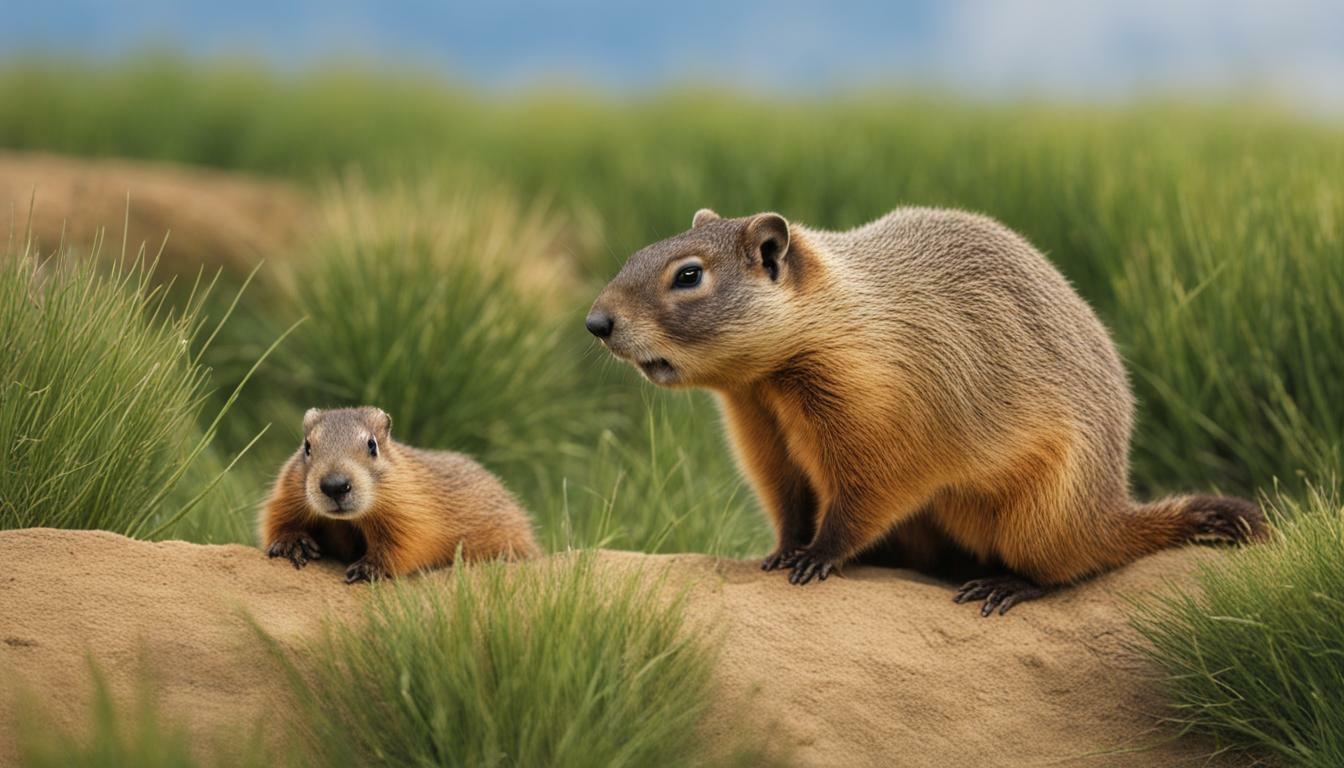Groundhogs and prairie dogs are both members of the Sciuridae family, but they have distinct differences that set them apart. In terms of physical appearance, groundhogs are typically larger, measuring around 26 inches long and weighing up to nine pounds, while prairie dogs are smaller, measuring around 16 inches long and weighing up to three pounds. Prairie dogs have a slimmer body and a thin tail, while groundhogs have heavier coats and heavy-duty claws for burrowing and climbing trees. When it comes to behavior, prairie dogs live in colonies spread over large areas, while groundhogs typically burrow with only a few others. Groundhogs also utilize methods like climbing trees or swimming to escape predators, in addition to hiding in their burrows. Overall, these two species may appear similar, but they have distinct differences.
Key Takeaways:
- Groundhogs are larger than prairie dogs, measuring around 26 inches long and weighing up to nine pounds, while prairie dogs measure around 16 inches long and weigh up to three pounds.
- Prairie dogs have a slimmer body and a thin tail, while groundhogs have heavier coats and heavy-duty claws.
- Prairie dogs form colonies spread over large areas, while groundhogs typically burrow with only a few others.
- Groundhogs use methods like climbing trees or swimming to escape predators, in addition to hiding in their burrows.
- Despite their similarities, groundhogs and prairie dogs have distinct differences that set them apart.
Physical Appearance
When it comes to physical appearance, groundhogs and prairie dogs exhibit notable differences. In terms of size, groundhogs are typically larger, measuring around 26 inches long and weighing up to nine pounds. On the other hand, prairie dogs are smaller, measuring around 16 inches long and weighing up to three pounds.
Another distinguishing factor is their body structure. Prairie dogs have a slender body and a thin tail, which helps them navigate their underground burrow systems. In contrast, groundhogs have a sturdier build with heavier coats and strong, heavy-duty claws that are well-suited for their burrowing and climbing needs. This difference in physique reflects their diverse habitats and lifestyles.
When observing these two species side by side, the differences in their physical characteristics are evident. Groundhogs and prairie dogs not only vary in size and weight but also possess unique features that enable them to thrive in their respective environments.
| Groundhogs | Prairie Dogs | |
|---|---|---|
| Average Length | 26 inches | 16 inches |
| Average Weight | Up to 9 pounds | Up to 3 pounds |
| Body Structure | Sturdy with heavy coats and strong claws | Slender with a thin tail |
Summary:
- Groundhogs are larger and heavier than prairie dogs, measuring around 26 inches long and weighing up to nine pounds.
- Prairie dogs, on the other hand, are smaller, measuring around 16 inches long and weighing up to three pounds.
- Body structure also sets them apart, with groundhogs having sturdier builds, heavier coats, and strong claws, while prairie dogs possess slender bodies and thin tails.
Stay tuned for the next section where we will explore the size and weight differences between groundhogs and prairie dogs!
Size and Weight
Groundhogs tend to be larger and heavier compared to prairie dogs. On average, groundhogs measure around 26 inches long and can weigh up to nine pounds, while prairie dogs are smaller, measuring approximately 16 inches long and weighing up to three pounds. These differences in size and weight contribute to their distinct physical appearances and behaviors.
When comparing their body structures, groundhogs have stockier builds with heavier coats of fur, allowing them to withstand colder temperatures. They also possess heavy-duty claws, ideal for digging burrows and climbing trees. On the other hand, prairie dogs have slimmer bodies and thinner tails, allowing them to swiftly navigate and communicate within their extensive burrow networks.
While groundhogs prefer to have fewer companions and tend to burrow alone or with just a few others, prairie dogs are highly social creatures, living in large colonies that span across vast areas. Their burrow systems are intricate and connect with each other, enabling them to communicate and stay vigilant against shared predators.
| Groundhog | Prairie Dog |
|---|---|
| Size: Approximately 26 inches long | Size: About 16 inches long |
| Weight: Up to nine pounds | Weight: Up to three pounds |
| Body Structure: Stocky build with heavy fur coats and heavy-duty claws | Body Structure: Slimmer body with a thin tail |
| Behavior: Burrow alone or with few companions | Behavior: Live in large colonies spread across wide areas |
In terms of defense mechanisms, groundhogs have the ability to climb trees or swim to escape predators, and they will retreat into their burrows for safety. Prairie dogs, with their highly social nature, rely on early warning systems within their colonies, emitting distinctive calls to alert each other of potential danger.
Overall, despite their shared membership in the Sciuridae family, groundhogs and prairie dogs have several distinctions that set them apart. From their physical appearances and burrowing habits to their social structures and defense strategies, understanding these differences enhances our appreciation for the unique qualities and adaptations of these fascinating creatures.
Body Structure
While both groundhogs and prairie dogs belong to the Sciuridae family, they have distinct body structures that serve different purposes.
Groundhogs, also known as woodchucks, are larger in size compared to prairie dogs. They can measure around 26 inches long and weigh up to nine pounds. Groundhogs have a sturdier build, with stockier bodies and strong limbs. These adaptations enable them to dig extensive burrows and climb trees for safety. They also have heavy-duty claws that aid in their burrowing and climbing activities.
On the other hand, prairie dogs are relatively smaller, measuring around 16 inches long and weighing up to three pounds. They have a slimmer body structure, which allows them to navigate through their complex underground burrow systems more efficiently. Prairie dogs also possess a thin tail, which aids in balance while standing upright and serves as a communication tool within their colonies.
Differences in Body Structure
To summarize, groundhogs have a robust and muscular physique, equipped with heavy coats and strong claws. In contrast, prairie dogs have a leaner body structure and an elongated tail, which assists them in their burrowing and communication endeavors.
| Groundhogs | Prairie dogs | |
|---|---|---|
| Average Length | Approximately 26 inches | Approximately 16 inches |
| Average Weight | Up to nine pounds | Up to three pounds |
| Body Structure | Stocky and muscular | Slender and agile |
| Tail Characteristics | N/A | Thin tail used for balance and communication |
| Adaptations | Heavy-duty claws for burrowing and climbing | Elongated bodies for efficient navigation in burrows |
Behavior
Groundhogs and prairie dogs exhibit unique behaviors that differentiate them from each other. Prairie dogs are highly social creatures, living in large colonies that can span over hundreds of acres. They communicate through a complex system of vocalizations and body postures, often standing upright to keep a lookout for potential predators. In contrast, groundhogs are more solitary animals, typically burrowing with only a few others in their family unit.
When it comes to escaping predators, groundhogs have developed several strategies. Not only do they retreat into their burrows at the first sign of danger, but they are also adept climbers, using their strong claws to scale trees and seek safety. They can even swim if necessary to evade threats. Prairie dogs, on the other hand, rely on their highly organized social structure and their ability to alert one another of potential dangers through a series of distinctive warning calls.
Another notable distinction between these two species is their burrowing habits. Groundhogs are known to create complex systems of burrows, often with several entrances and chambers. These burrows not only serve as their homes, but also provide protection from predators. Prairie dogs, on the other hand, construct elaborate underground tunnels with interconnected chambers, which they use for different purposes such as sleeping, raising young, and storing food.
| Groundhogs | Prairie Dogs |
|---|---|
| Live in smaller family units | Live in large colonies |
| Use burrows for protection and hibernation | Construct complex tunnel systems for various purposes |
| Employ climbing and swimming as escape strategies | Rely on social structure and vocal warnings |
In conclusion, groundhogs and prairie dogs may share some similarities as members of the Sciuridae family, but their behaviors set them apart. Groundhogs prefer a solitary lifestyle, utilizing their burrows and adaptable escape strategies to ensure their survival. Prairie dogs, on the other hand, thrive in large social colonies, relying on their intricate communication system to protect their community. Understanding these behavioral distinctions contributes to a deeper appreciation for the diverse natural world around us.
Prairie dogs are known for their complex social structure, while groundhogs typically live a more solitary lifestyle. Prairie dogs live in large colonies, which can consist of hundreds of individuals spread over large areas. Within these colonies, they establish intricate communication networks through a series of vocalizations and movements. They also exhibit cooperative behaviors, working together to maintain and defend their burrows.
Groundhogs, on the other hand, are more inclined to live alone or in small family groups. They typically dig and maintain their burrows independently, using their heavy-duty claws to create complex tunnel systems. Although groundhogs may share burrows with a few other individuals, they do not form large colonies like prairie dogs.
In terms of behavior, prairie dogs are highly social and spend a considerable amount of time interacting with one another. They engage in grooming, play, and even engage in “kissing” behaviors. Groundhogs, however, are often more focused on individual activities such as foraging for food or defending their territory.
While both groundhogs and prairie dogs exhibit interesting behaviors and adaptations, their social structures and preferred lifestyles differ significantly. These distinctions contribute to the uniqueness of each species and their respective roles in the natural world.
Burrowing Habits
Groundhogs and prairie dogs demonstrate distinct burrowing habits that align with their unique lifestyles. Prairie dogs are known for creating complex burrow systems that can span vast areas, forming interconnected tunnels and chambers. These burrows serve as shelter, protection from predators, and a means of communication within their colony. Prairie dogs are meticulous architects, constructing multiple entrances, as well as separate chambers for sleeping, raising their young, and even storing food.
On the other hand, groundhogs prefer to dig simpler burrows, typically with only one entrance. Their burrows are designed for individual use, with a main tunnel leading to a chamber where they hibernate during winter months. While groundhogs may share their burrows with a mate or their offspring, they tend to be more solitary in their burrowing habits compared to prairie dogs.
Both groundhogs and prairie dogs are well-adapted to their burrowing lifestyle. Groundhogs have strong claws designed for digging into the ground, allowing them to create their burrows efficiently. Prairie dogs, on the other hand, have distinctive front teeth that continuously grow, enabling them to chew through the hard-packed soil and create their intricate burrow systems.
| Groundhogs | Prairie Dogs | |
|---|---|---|
| Number of Entrances | Usually one | Multiple entrances, interconnected tunnels |
| Chamber Complexity | Simple with a main chamber for hibernation | Elaborate with separate chambers for sleeping, raising young, and storing food |
| Usage | Often solitary or with a mate/offspring | Colony-based living with multiple individuals |
In summary, while both groundhogs and prairie dogs exhibit burrowing behaviors, their approaches and purposes for burrowing differ. Groundhogs prefer solitary and simple burrows, mainly for hibernation, while prairie dogs create complex interconnected burrow systems for communication and colony living. These burrowing habits allow each species to thrive in their distinct environments and contribute to the rich diversity of the natural world.
Defensive Strategies
Groundhogs and prairie dogs have developed different defensive strategies to ensure their survival in their respective habitats. While both species face threats from predators, they have adapted unique methods to protect themselves.
Groundhogs, also known as woodchucks, have a few defensive mechanisms in place. When confronted by a predator, such as a fox or dog, they have the ability to quickly retreat to their burrows. These burrows can have multiple entrances, allowing groundhogs to escape from danger. Additionally, groundhogs are skilled climbers and can quickly ascend trees to avoid predators on the ground. Their strong claws enable them to climb with ease, providing further protection. If necessary, groundhogs can also take to the water, swimming across streams or ponds to evade threats.
Prairie dogs, on the other hand, have evolved a different set of defensive strategies. These social creatures live in large colonies, which act as a form of protection. Prairie dogs have developed complex burrow systems that provide shelter for the entire colony. When a predator approaches, prairie dogs emit warning calls, alerting others to the danger. The colony works together to keep watch, ensuring that potential threats are detected early. Prairie dogs are also known for their agility and speed. They have the ability to quickly retreat into their burrows, using their smaller size and slender bodies to their advantage.
Habitat-specific Adaptations
These different defensive strategies correspond to the specific habitats in which groundhogs and prairie dogs reside. Groundhogs are primarily found in woodland areas, with access to trees and bodies of water. Their ability to climb trees and swim provides them with multiple escape routes. Prairie dogs, on the other hand, inhabit open grasslands and prairies. The vastness of these habitats necessitates a communal defense strategy, with prairie dogs relying on their colony’s collective vigilance to ward off predators.
| Groundhogs | Prairie Dogs |
|---|---|
| Retreat to burrows | Retreat to burrows |
| Climbing trees | Warning calls to alert colony |
| Swimming | Agility and speed |
In summary, groundhogs and prairie dogs have developed distinct defensive strategies to survive in their respective habitats. Groundhogs rely on their ability to retreat to burrows, climb trees, and swim, while prairie dogs depend on their complex burrow systems, warning calls, and agility. These adaptations showcase the remarkable resilience and adaptability of these two unique species.
Habitat
Groundhogs and prairie dogs can be found in different habitats, each with its own unique characteristics. Groundhogs, also known as woodchucks, prefer wooded areas, fields, and grasslands. They are often found in regions of North America, such as the eastern United States and parts of Canada, where these types of habitats are abundant. Groundhogs build elaborate burrow systems underground, which provide them with shelter and protection from predators.
Prairie dogs, on the other hand, thrive in open grasslands and prairies. They are primarily found in the central and western regions of North America, such as the Great Plains. Prairie dogs are highly social animals and live in large colonies, which are made up of interconnected burrows. These burrows not only serve as their homes but also play a crucial role in maintaining the ecosystem of the grasslands they inhabit.
The specific characteristics of the habitats favored by groundhogs and prairie dogs result in different environmental impacts. Groundhogs, with their burrows and feeding habits, can sometimes affect agricultural lands and gardens. On the other hand, prairie dogs are considered a keystone species, as their burrows promote soil aeration, affect water drainage patterns, and provide habitats for other animals.
| Groundhogs | Prairie Dogs |
|---|---|
| Wooded areas, fields, grasslands | Open grasslands, prairies |
| Eastern United States, Canada | Central and western North America |
| Elaborate burrow systems | Large interconnected burrow colonies |
| Potential impact on agricultural lands and gardens | Keystone species with positive environmental impacts |
Ecological Importance
Both groundhogs and prairie dogs play vital roles in their ecosystems, contributing to biodiversity and ecosystem health. Groundhogs, also known as woodchucks, are considered a keystone species in their habitats. Their burrowing activities not only create underground tunnels but also aerate the soil, allowing for better water absorption and nutrient circulation. This, in turn, promotes the growth of vegetation and benefits other animals that rely on these plants for food and shelter.
Prairie dogs, on the other hand, are ecosystem engineers. Their prairie habitats are transformed by their extensive burrowing systems, which form complex underground networks. These burrows provide shelter for a wide range of species, including reptiles, mammals, and birds. Additionally, prairie dogs are herbivores and play a crucial role in shaping the grasslands they inhabit. By grazing on grasses and other vegetation, they help maintain the balance of plant species and prevent the dominance of certain plants.
Groundhog and Prairie Dog Interactions
While groundhogs and prairie dogs have distinct differences in their behavior and habitat preferences, their interactions can have interesting ecological implications. In areas where their ranges overlap, groundhogs may utilize abandoned prairie dog burrows for shelter, taking advantage of the intricate tunnel systems. This interaction benefits both species, as groundhogs find ready-made homes while prairie dogs benefit from the groundhogs’ burrowing activities, which further enhance the structure and functionality of the burrow network.
In conclusion, groundhogs and prairie dogs are important players in their respective ecosystems, each making unique contributions to the environment. Their distinctive behaviors, physical characteristics, and ecological roles highlight the diversity and complexity of the natural world.
| Groundhogs | Prairie Dogs |
|---|---|
| Size: Up to 26 inches long | Size: Around 16 inches long |
| Weight: Up to 9 pounds | Weight: Up to 3 pounds |
| Physical features: Heavy coat, heavy-duty claws | Physical features: Slim body, thin tail |
| Behavior: Typically burrow with few others | Behavior: Live in colonies spread over large areas |
| Defensive strategies: Climbing trees, swimming, hiding in burrows | Defensive strategies: Alarm calls, hiding in burrows |
Conclusion
In conclusion, groundhogs and prairie dogs share similarities but also possess distinct features that differentiate them from each other.
Factual data reveals that both species belong to the Sciuridae family, but groundhogs tend to be larger, measuring around 26 inches long and weighing up to nine pounds, while prairie dogs are smaller, measuring around 16 inches long and weighing up to three pounds. Groundhogs have heavier coats and heavy-duty claws for burrowing and climbing trees, whereas prairie dogs have a slimmer body and a thin tail.
Behaviorally, prairie dogs live in colonies spread over large areas, while groundhogs typically burrow with only a few others. Groundhogs employ various strategies, such as climbing trees or swimming, to escape predators, in addition to hiding in their burrows.
Overall, while groundhogs and prairie dogs may appear similar at first glance, they possess distinctive physical characteristics, behaviors, and habitats that set them apart. Understanding these differences allows us to appreciate the unique features and contributions of each species in the natural world.
FAQ
Are groundhogs and prairie dogs the same species?
No, they are both members of the Sciuridae family but have distinct differences.
How do groundhogs and prairie dogs differ in physical appearance?
Groundhogs are larger, measuring around 26 inches long and weighing up to nine pounds, while prairie dogs are smaller, measuring around 16 inches long and weighing up to three pounds.
What are some physical characteristics that differentiate groundhogs and prairie dogs?
Groundhogs have heavier coats and heavy-duty claws for burrowing and climbing trees, while prairie dogs have slimmer bodies and thin tails.
Do groundhogs and prairie dogs have different behaviors?
Yes, prairie dogs live in colonies spread over large areas, while groundhogs typically burrow with only a few others. Groundhogs also utilize methods like climbing trees or swimming to escape predators.
How do groundhogs and prairie dogs differ in their social structure?
Groundhogs typically live solitary lives or with only a few others, while prairie dogs live in large colonies.
What are the differences in the burrowing habits of groundhogs and prairie dogs?
Groundhogs and prairie dogs have differences in their burrow systems and purposes. Groundhogs use burrows for hibernation and protection, while prairie dogs create elaborate tunnel systems for communication and protection.
What are some defensive strategies employed by groundhogs and prairie dogs?
Groundhogs have the ability to climb trees and swim to escape predators, in addition to hiding in their burrows. Prairie dogs rely on warning calls and their group defense system to fend off threats.
What are the preferred habitats of groundhogs and prairie dogs?
Groundhogs prefer wooded areas and open fields, while prairie dogs thrive in grasslands and open prairies.
Why are groundhogs and prairie dogs ecologically important?
Groundhogs and prairie dogs play important roles in their respective ecosystems, such as aerating soil, influencing plant growth, and providing food for predators.
Source Links
- https://sciencing.com/difference-between-groundhog-prairie-dog-8092215.html
- https://www.fox43.com/article/life/animals/whats-the-difference-between-groundhogs-and-prairie-dogs-fox43/521-3ff04ed8-4a06-4c58-a4e7-00db0a7a3b3e
- http://www.differencebetween.net/science/nature/difference-between-prairie-dog-and-groundhog/




